At CarnivoreWeb.com, we independently review products and outfitters. However, we may earn a commission when you purchase products through links on our site. Read our affiliate policy. Read about how we test products.
From mouth calls to box calls, we review the best turkey calls on the market to help you find the right sound for your next hunt.
The idea is to get a turkey’s attention, and if you spend enough time hunting and running turkey calls, you develop an ear for calls that work and those that sound like a squeaky door hinge.
Trust me, making turkey call sounds is part art, science, and talent. It takes time in the woods to understand which call to use in what season and at what time of the day. No one call does it all when it comes to turkey hunting. You need a repertoire of turkey calls to locate and then convince a wily tom that he needs to check you out.
How I Chose The Best Turkey Calls
Over the years, I’ve used a lot of different turkey calls and most of them end up in my box of misfits. Some work while others sound like beginner’s band practice. Like most turkey hunters, I started with a turkey box call, quickly graduated to a pot call, and, as I like to think, I am still mastering the language of turkey mouth calls.
What I look for in a call is sound, performance, and ease of use. Sound is the ability of the call to emulate a real turkey. Can the call produce a purr, yelp, cutt, kee-kee, and cluck? Next is performance and how turkeys react to the call. I have had toms come running in at breakneck speed to some calls, with other calls, birds have completely ignored me. The third criterion, in my opinion, with a wild turkey call, is ease of use. Box calls and slate calls are easy to master, but they are not hands-free. You know how it is when a tom is interested and you need to quickly ease the call down and slowly get the shotgun into position. A mouth call is hands-free, but mouth calls are hard to master.
Turkey call prices range widely from inexpensive plastic calls to handmade heirloom-quality wood calls. Price does not always dictate a quality call.
Best Turkey Calls
- Best Turkey Mouth Call: Woodhaven Ninja Ghost
- Best Turkey Pot Call: ESH Old Hunter Classic
- Best Turkey Box Call: Lynch World Champion Turkey Call Model No. 102
- Best Beginner Turkey Call: H.S. Strut Cookie Cutt’R Tracer Lid Pot Call
- Best All-Weather Turkey Call: Houndstooth Game Calls Dixie Ceramic Call
- Best Turkey Locator Call: Quaker Boy Owl Hooter
Best Turkey Mouth Call: Woodhaven Ninja Ghost
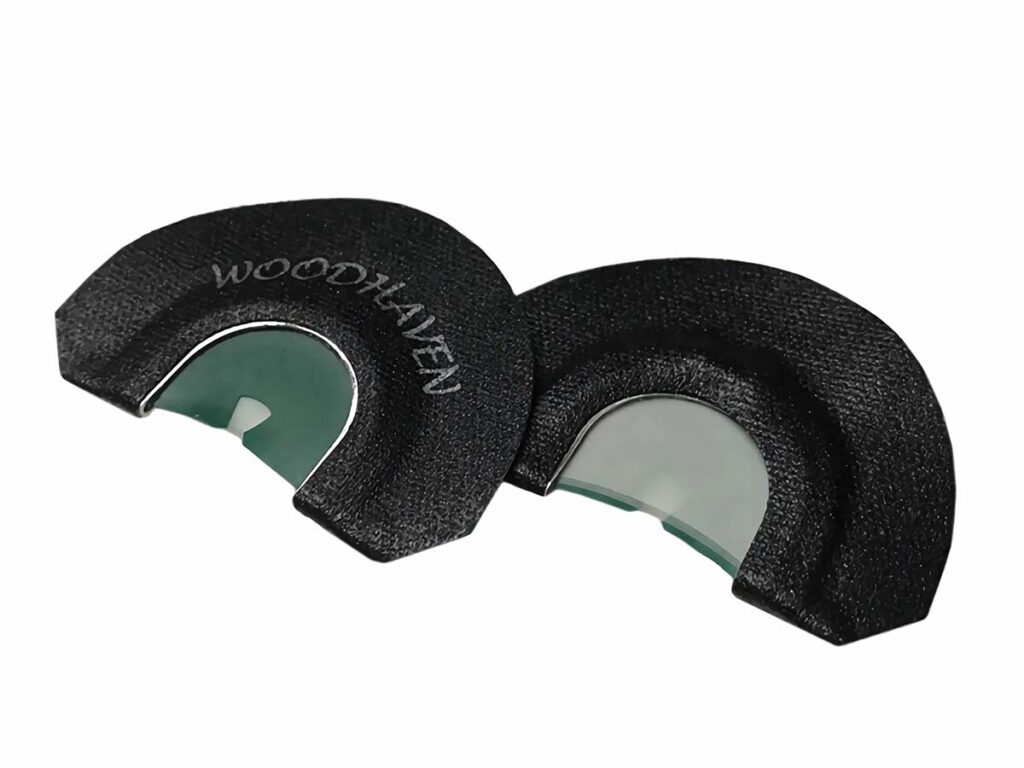
Pros
- Easy to use, even for a beginner
- Realistic hen sounds
Cons
- Too pedestrian a mouth call for experts
It is hard to find a good turkey mouth call. I either gag on them or make a slurring sound like a hen who has had too much Wild Turkey. The 101 proof kind. Not with the Woodhaven Ninja Ghost.
This is one of the easiest mouth calls I’ve used. It’s built with a three-reed design for clean and realistic sounds and it is super easy to run. There is a small ghost-style cut in the middle of the top reed, which does require a lot of air pressure, yet I can still make a melody of turkey sounds.
Ninja Ghost Deals
Best Turkey Pot Call: ESH Old Hunter Classic
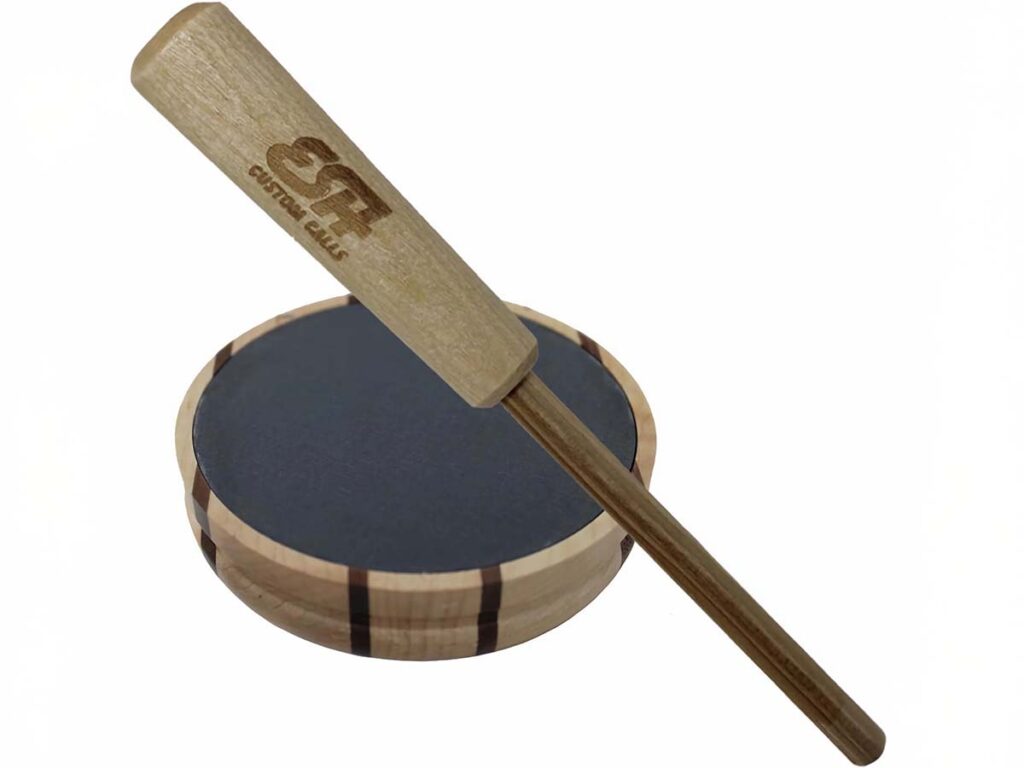
Pros
- Beautiful construction
- Realistic sound
Cons
- Expensive
In the spring, you should hear me yelp, cut, and cluck with a slate call. Slate calls, also referred to as pot calls or friction calls, make it easy to create realistic sounds without much practice.
A pot call has two parts: the round-shaped base that holds a material such as slate, ceramic, glass, crystal, or aluminum. Hence, the reason many turkey hunters call them slate calls is that slate was the most popular material used.
The second piece is the striker, which is made of wood, carbon or aluminum. Drawing the striker across the pot surface of the material, which creates friction and mimics turkey sounds, including yelps, clucks, and cuts.
I still use an old H.S. Strut Li’l Deuce slate call, but I’ve upgraded to the ESH Old Hunter Classic. The ESH pot call is constructed with a cherry and walnut horizontal laminate. The soundboard is made of glass and the sticker is made of Dymondwood and hickory.
Old Hunter Classic Deals
Best Turkey Box Call: Lynch World Champion Turkey Call Model No.102
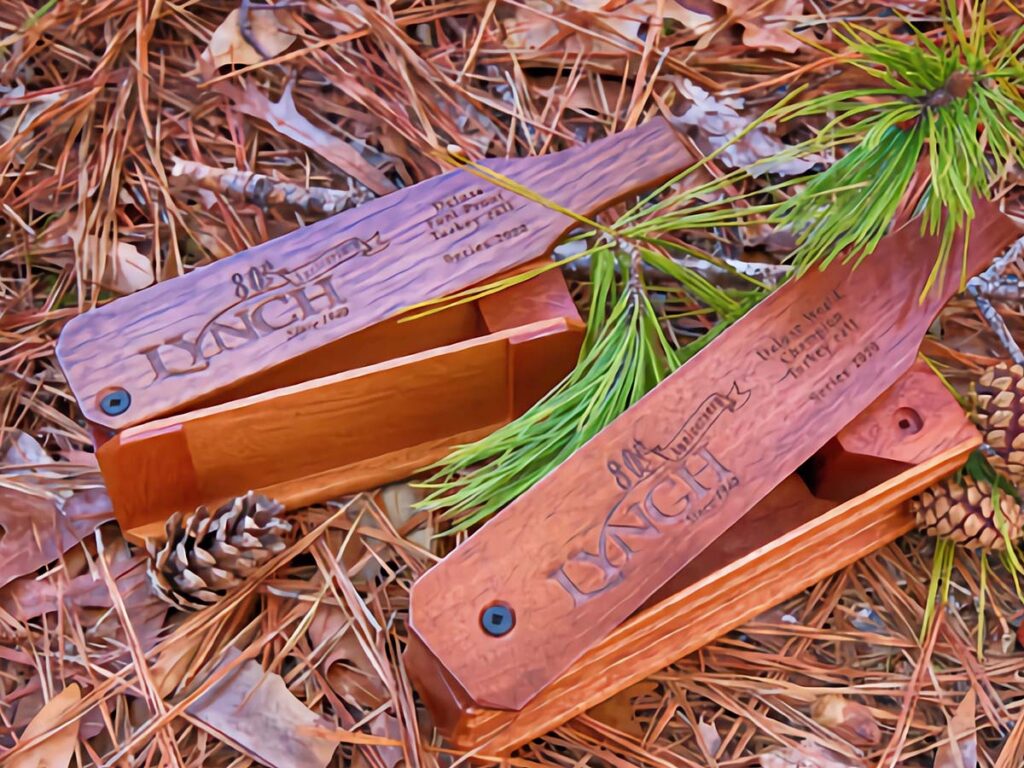
Pros
- Versatile, produces many different sounds
- Easy to use
- Traditional wood construction
Cons
- Needs maintenance like chalk and rubber bands
Lynch box calls have been making turkey calls since 1940. I’ve used the Model 102 wild turkey box call as my go-to box call for years. It is versatile and great for beginners as well as old pros.
The call can be used to make a variety of sounds depending on how you work the lid. I’ve used Model 102 to locate roosting turkeys and the soft hen sounds to entice gobblers to fly down and say hello. Whines, yelps, cackles, clucks are all easy to master with the Lynch Model 102 because it has two sounding boards, one on each side. One side is for hens and the other is for gobblers.
Model No.102 Deals
Best Beginner Turkey Call: H.S. Strut Cookie Cutt’R Tracer Lid Pot Call
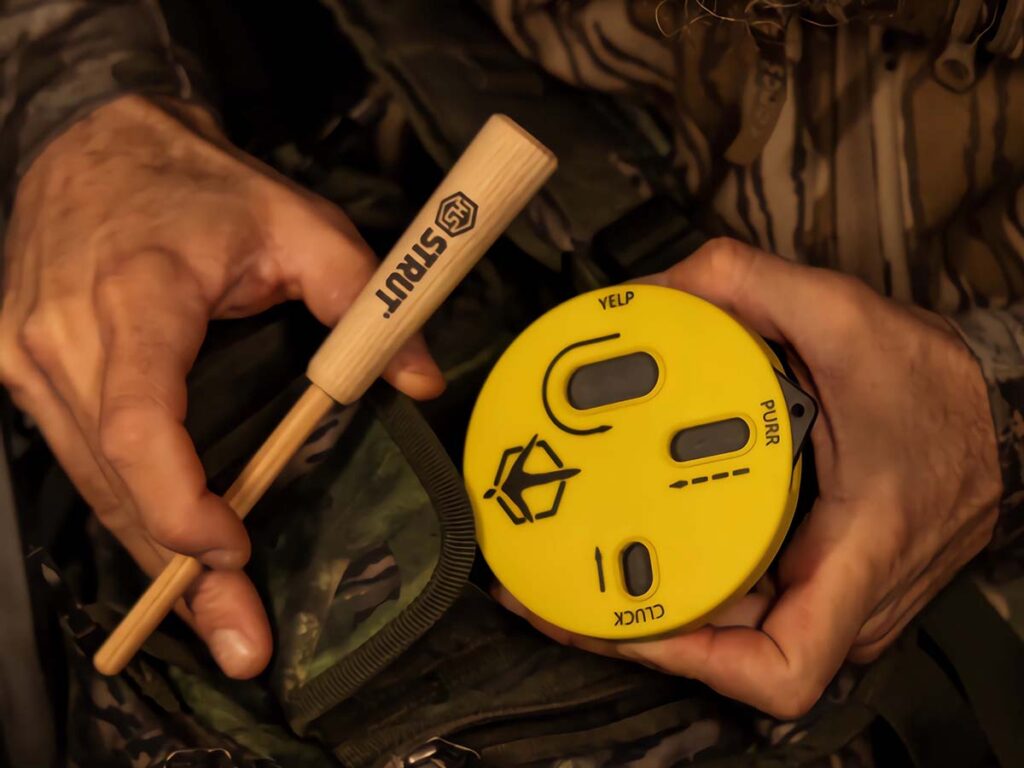
Pros
- Easy to use
- Inexpensive
Cons
- Slate surface isn’t good in rain
The H.S. Strut Cookie Cutt’R call features a polymer lid that fits over the pot with quick reference slots for yelping, clucking and purring. Just insert the striker tip in the slot and drag it in the direction of the arrows. This allows a beginner to produce basic and consistent calls every time. Once you become proficient, the lid can be removed.
Cookie Cutt’R Deals
Best All-Weather Turkey Call: Houndstooth Game Calls Dixie Hen
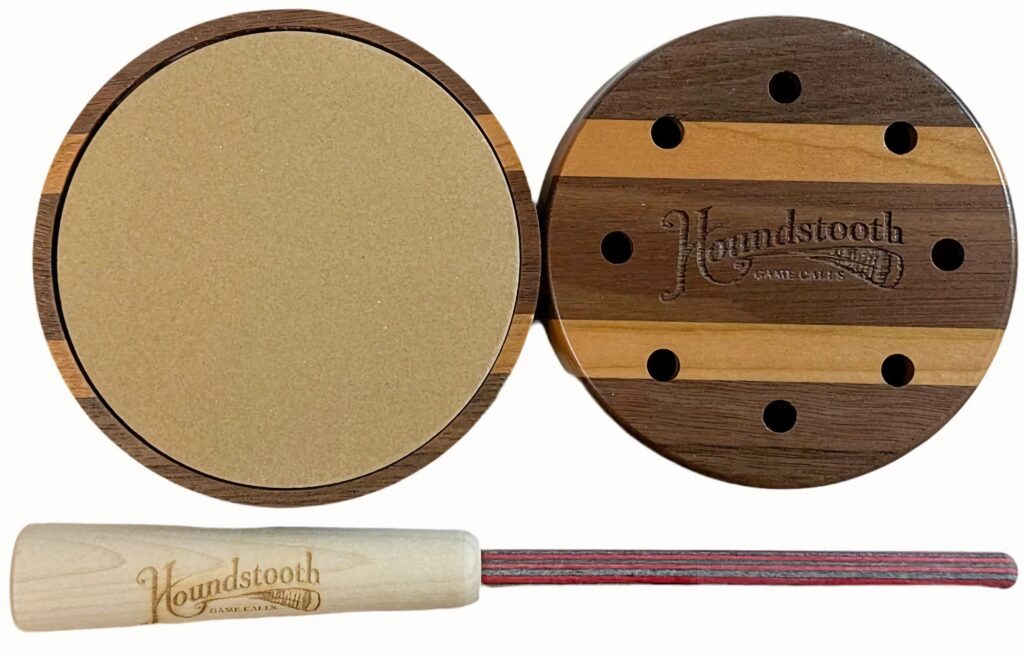
Pros
- Works in the rain
- Easy to run
Cons
- Could be louder
- Expensive
Rain can put a damper on your pot call, especially if it’s made of slate. A pot call with a ceramic surface is a good choice if the weather turns wet. Houndstooth Game Calls Dixie Hen Ceramic Call is a do-it-all call that produces sounds from high-end cuts to strong yelps. It is user-friendly, too. The surface is ceramic and the two-piece diamond wood striker makes calling easy in inclement weather.
Dixie Hen Deals
Best Turkey Locator Call: Quaker Boy Owl Hooter
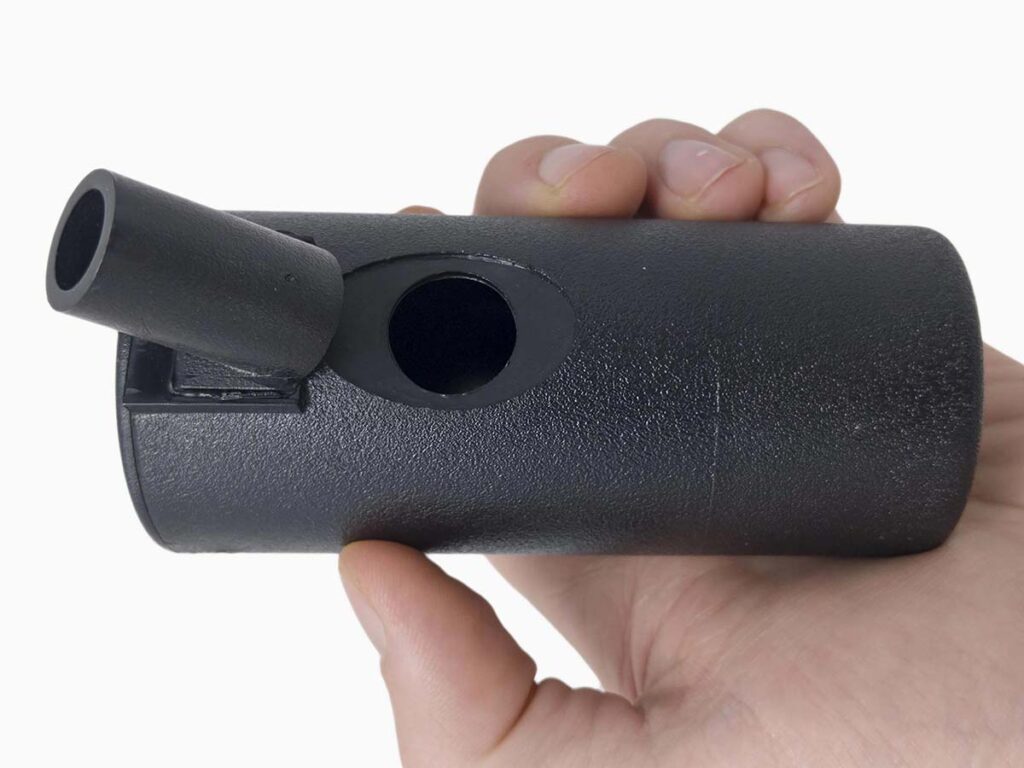
Pros
- Inexpensive
- Easy to use
- Good tones
Cons
- Would be handier with a lanyard
The Quaker Boy Owl Hooter has been around for ages because it is not only easy to use, but it is effective at eliciting gobbles from roosting turkeys before daybreak.
The call offers two tones to get a high pitch and a deeper tone by putting your finger over the hole on the end of the call. With any owl locator call, it is all about blowing the cadence of “Who cooks for you? Who cooks for you all?” The Owl Hooter is compact and made of plastic, so it is lightweight and easy to tote in your vest pocket.
Owl Hooter Deals
Turkey Mouth Call Cuts
Mouth calls for turkey hunting are built with different cuts in the reeds. The reeds are layers of stretched latex with small slits in the latex made to produce different sounds.
- Double-Cut: Easy for beginners to make tree yelps and kee-kees.
- W-Cut: a good all-purpose yelper.
- Bat-Wing Cut: Another all-purpose call with a broader rasp range than a Double-Cut.
- Split-V: Used for soft to medium easy yelps and cuts.
- Cutter: Designed for loud, long-range cutting and requires a lot of air pressure to use.
- Ghost Cut: Easy to use and works well for kee-kees, whistles, yelps, and soft rasps.
Turkey Call FAQ
Are expensive turkey calls worth it?
Generally speaking, more expensive call are typically made with better materials, sound better an are easier to use. That said, with practice, an inexpensive call will call a turkey in. The variable is you the hunter and how much time you spend master the call.
Are slate or glass turkey calls better?
Slate and glass turkey calls each have their place in the woods. Slate calls produce smooth, mellow tones that excel at soft, close-range work and are easy for beginners to master, but they struggle in wet weather. Glass calls, on the other hand, deliver sharper, higher-pitched sounds that cut through wind and distance and perform better in moisture, though they can be trickier to condition.
What sound scares wild turkeys?
Wild turkeys are easily spooked by anything sudden or unnatural. Predator calls, human noises like talking or clanking gear, and loud disturbances such as barking dogs or gunshots will quickly send them running. Even poorly timed or unrealistic turkey calls can make them wary. In short, any sound that feels out of place or signals danger is likely to scare a wild turkey.
How far away can a turkey hear a call?
Wild turkeys have excellent hearing, and under the right conditions, they can pick up calls from well over a mile away. Softer calls like purrs and clucks usually only carry a few hundred yards, but sharp, high-pitched yelps or cutting—especially from a glass or aluminum call—can travel much farther.
Why You Can Trust CARNIVORE
Since its launch, CarnivoreWeb.com has been a trusted authority on hunting, fishing and wild food, delivering expert insight for outdoorsmen who live the field-to-table lifestyle. More than a hunting and fishing site, CarnivoreWeb.com covers the full spectrum of the modern outdoors—from rifles, bows, and fishing gear to cooking, conservation and adventure.
Our contributors are drawn from across the hunting and angling world, including seasoned guides, lifelong hunters, competitive shooters and outdoor writers with decades of field experience. Every review, article and feature is built on firsthand testing, deep research, and an unwavering commitment to accuracy.
Commitment to Journalistic Principles
At CarnivoreWeb.com, upholding journalistic integrity is our top priority. We follow strict editorial standards to ensure all content is accurate, transparent, and unbiased. Our editors and writers operate independently, free from outside influence, advertisers or stakeholders. We adhere to established journalistic codes of ethics, holding ourselves accountable for the information we publish, correcting errors when they occur and disclosing any potential conflicts of interest.
This commitment ensures that our readers can trust CarnivoreWeb.com to provide reliable, honest coverage that helps them make informed decisions—whether selecting gear, honing outdoor skills or preparing wild game.
Find out more about our Editorial Standards and Evaluation Process



